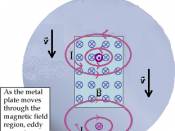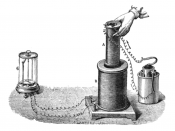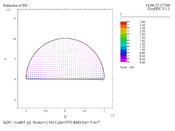1. With this definition of the flux being , we can now return to Faraday's investigations. He found that the magnitude of the emf produced depends on the rate at which the magnetic flux changes. Faraday found that if the flux through N loops of wire changes by an amount , during a time delta t, the average induced emf during this time is
This fundamental result is known as Faraday's law of induction.
The minus sign is placed there to remind us in which direction the induced emf acts. Experiment shows that an induced emf always gives rise to a current whose magnetic field opposes the original change in flux. This is known a Lenz's law. Let us apply it to the case of relative motion between a magnet and a coil. The changing flux induces an emf, which produces a current in the coil; and this induced current produces its own magnet field.
If the distance between the coil and the magnet decreases; so the magnetic field, and therefore the flux, through the coil increases. The magnetic field of the magnet points upward. To oppose this upward increase, the field produced by the induced current must point downward. Thus Lenz's law tells us that the current must move by the use of the use of the right hand rule. If the flux decreases, so the induced current produces an upward magnetic field that is 'trying' to maintain the status quo.
Let us consider what would happen if Lenz's law were just the reverse. The induced current would produce a flux in the same direction as the original change; this greater change in flux would produce an even larger current, followed by a still larger change in flux, and so on. The current would continue to grow...


